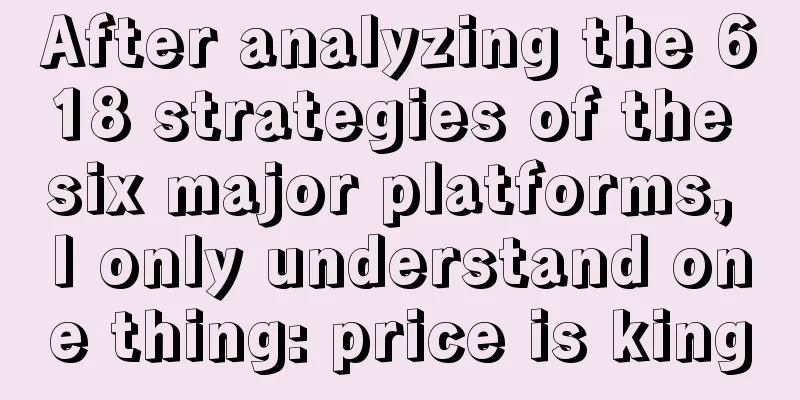"Start from the heart and ride the wind and waves": cleverly use emotional marketing to seize new opportunities under the wave of consumption upgrade

Recently, "dopamine" and "Malade" have become hot marketing words. The color marketing represented by them has swept through fashion-related industries such as clothing and beauty. Cultural tourism in cities such as Zibo, Harbin, and Tianshui has become popular, and entertainment and leisure activities such as camping, City Walk, taverns, and concerts have become new favorites of consumers. Behind these phenomenal marketing hotspots lies a common marketing strategy: emotional marketing. 1. What is emotional marketing?Emotional marketing, by creating content, stories and experiences that resonate with the target audience, aims to stimulate positive or specific emotional responses such as joy, love, sympathy, nostalgia, desire, belonging, etc., thereby building brand awareness in the audience's mind, promoting their purchases and sales, or enhancing customer loyalty. A number of popular cases have undoubtedly proved the effectiveness of this strategy in the current marketing environment, and at the same time have caused many marketers to think: Why has emotional marketing suddenly exploded at this time? How can brands master and use this strategy? In recent years, my country's economy has developed rapidly, and a wave of consumption upgrading has followed. After the target audience, especially young people, have achieved the satisfaction of basic material needs from quantity to quality, they naturally have the consumption demand for emotional and spiritual levels. The fast-paced and high-pressure modern life has made people more and more eager to release emotions and express themselves, further stimulating the rapid expansion of related demand. If a brand can gain insight into relevant consumer needs and provide corresponding emotional value through products, services, communications, and activities, it can create an extremely pleasant emotional experience for the target audience and stimulate their favor and recognition of the brand. The popularity of social media allows individuals to easily express their feelings, and it is also easy for them to spread virally to infect more people, thereby triggering unconscious resonance among the group and making the power of emotional marketing grow exponentially. In this context, emotional marketing has become the basic skill that brands need to ride the wave of consumption upgrading. 2. So, how can we do emotional marketing well?This requires brands to be able to accurately understand and effectively grasp the emotional consumption needs of the target audience, accurately grasp the emotional touchpoints based on their own brand positioning, integrate brand culture into innovative and personalized marketing activities, establish emotional links and create emotional resonance, thereby achieving brand value enhancement and market positioning. Among them, insight into emotional consumption needs and identification of emotional touchpoints are the basis for conducting emotional marketing. Understanding emotional consumption needs means digging deep into the target audience’s inner needs, preferences, lifestyles, and factors that can cause their emotional fluctuations. This includes not only superficial statistics (such as age, gender, occupation, etc.), but more importantly, exploring their inner state, values, and important moments in life. Identifying emotional touchpoints is about finding those specific emotions or life situations that can resonate with the target audience. These emotional touchpoints involve both positive and negative aspects of human emotions, including happiness, surprise, sadness, anger, disgust, fear, etc. Correctly identifying these touchpoints and cleverly combining them with brand information can effectively stimulate the audience's emotional response, thereby deepening their memory and favorability towards the brand. For example, for young consumers who are looking for novel experiences, brands can create joy and surprise through limited-time promotions, surprise gifts or interactive games on social media to increase customer engagement and brand favorability. For scenarios that inspire sympathy and social responsibility, public welfare marketing becomes an effective means. By telling touching stories or cooperating with non-profit organizations, brands can arouse the public's empathy, promote charitable donations and positive actions, and highlight corporate values. In-depth understanding and flexible use of these emotional marketing strategies can help companies shape a unique brand image in a complex and changing market and establish lasting customer loyalty. In the process of emotional marketing, brands need to use innovative means to link emotional touchpoints to stimulate resonance among target audiences, create and amplify positive emotions to provide emotional value, or help target audiences vent and eliminate negative emotions to increase overall emotional value. This is the essence of emotional marketing. Mobilizing the target audience's senses to stimulate emotional cognition is an important means to successfully implement emotional marketing. Whether it is innovation in the form of communication, such as scent marketing, color marketing, auditory marketing, or immersive experience technologies based on AR, VR, MR, etc. to stimulate the audience's senses, or the careful design of mental communication such as public welfare activities, film and television implants, celebrity endorsements, etc., as long as it targets emotional touchpoints and combines brand culture with careful planning, good results can be achieved. In addition, mobilizing the audience's participation, experience and sharing is very important for emotional marketing. This helps to create emotional resonance, allows them to personally experience the brand culture, creates an emotional connection between the two parties, collects feedback in a timely manner to optimize strategies, and stimulates the group's emotional resonance through the audience's spontaneous sharing, thereby amplifying marketing potential and expanding brand influence. It cannot be ignored that the rapid development of artificial intelligence (AI) technology is leading emotional marketing into a new stage. AI technology can help brands deeply analyze consumer data, including facial expressions, voice intonation and text content, and accurately understand their emotional state, thereby enabling brands to monitor social media sentiment in real time and quickly adjust strategies to meet consumer needs. It can also make more refined and personalized recommendations based on observations of consumers’ emotions, customize products and services according to individual emotions and interests, stimulate emotional resonance and establish emotional connections. At the same time, AI technology can support brands in creating dynamic content and automatically generate advertising materials that fit personal emotions, such as copy, videos, and music, thereby creating a highly personalized immersive marketing experience and enhancing the emotional connection between brands and consumers. Finally, it should be noted that emotional marketing must adhere to brand positioning, revolve around strategic goals, strengthen rather than deviate from brand personality, ensure that emotional marketing activities complement brand image, and create clear and coherent brand awareness for the audience. Clear marketing goals should also be set to ensure that while touching the emotions of the target audience, it can also effectively promote market expansion and brand development. Emotional marketing is just a means, and like other marketing means, its goal is to implant brand positioning into the minds of the audience. Therefore, this means that every attempt to touch consumers’ emotions should be creatively planned and executed around brand positioning, striving to push user cognition to a position close to brand positioning, and setting clear marketing goals; Whether it is to increase brand awareness, enhance consumer loyalty, or drive short-term sales growth, it is necessary to ensure that each emotional marketing activity is closely centered around brand positioning and moves towards the brand vision, so as to maximize short-term marketing effects and achieve a balanced pull of long-term brand attention. 3. ConclusionThe core of emotional marketing is to establish emotional links. Brands need to continue to explore and practice to touch consumers' emotions in innovative ways, but they must pay attention to adhering to brand positioning and long-term attention, maintaining brand consistency and integrity, and avoiding emotional falsehood caused by excessive commercialization. Through genuine communication and high-quality experiences, brands can carve out a place in the hearts and minds of consumers and achieve long-term business success. It should also be noted that the success of emotional marketing depends not only on creativity and strategy, but also on whether the brand can continue to pay attention to the emotional changes of consumers, adjust strategies in a timely manner, and grow together with consumers. In this process, AI technology and data analysis will become indispensable tools to help brands better understand consumers and achieve more accurate and humane emotional marketing. Author: Chen Hao Marketing Expert WeChat Official Account: Brand Market Relativity This article was originally published by @品牌市场与论 on Operation Party. Any reproduction without permission is prohibited. The title image is from Unsplash, based on the CC0 agreement |
<<: With Xiaohongshu, brand marketing has entered the "individual era"
Recommend
How to open a cross-border e-commerce store at home? How to do it at home?
Cross-border e-commerce is aimed at the global mar...
How does Amazon handle holidays during the Chinese New Year? How do you handle holidays during the holidays?
Basically, whether or not the e-commerce platform ...
The worse your ability, the more confident you are? Understanding these things when writing a plan will help you avoid taking detours
When you meet someone who "does not listen, c...
The life and death situation of traditional retail in the digital age: What lesson did the "breakout battle" of Pangdonglai and Yonghui teach the industry?
Store adjustments are no longer simple renovation ...
What does an Amazon self-delivery job do? How to increase sales?
In fact, the number of sellers opening stores on A...
What does eBay import fee mean? How to collect it?
When opening a store on eBay, in fact, many newbie...
Is the return rate high on Shopee? What are the rules?
Cross-border e-commerce has now become the first c...
How is the listing price calculated for cross-border e-commerce? What are the listing rules?
In recent years, cross-border e-commerce platforms...
Data Operations | The first step to using data—finding data
This article is an in-depth discussion on data ope...
Is it easy to sell adult products on Amazon? Will the store be closed?
Before opening a store on the Amazon platform, the...
The “supermarketization” of mass-market snacks is accelerating, and the performance of traditional snacks is diverging
"The snack industry is changing rapidly, and ...
How to improve Lazada product rankings? Start with these points
When we run an online store, we need to find ways ...
Must learn! Xiaohongshu released [Store Broadcast 3+3 Management Method]!
Xiaohongshu has just released the "Simple Liv...
This New Year Goods Festival, they bring back the New Year atmosphere
The New Year is coming, have you prepared the New ...
Did you make money or lose money by following the trend and opening a Zibo barbecue restaurant?
The "Zibo BBQ" craze has not only made Z...









